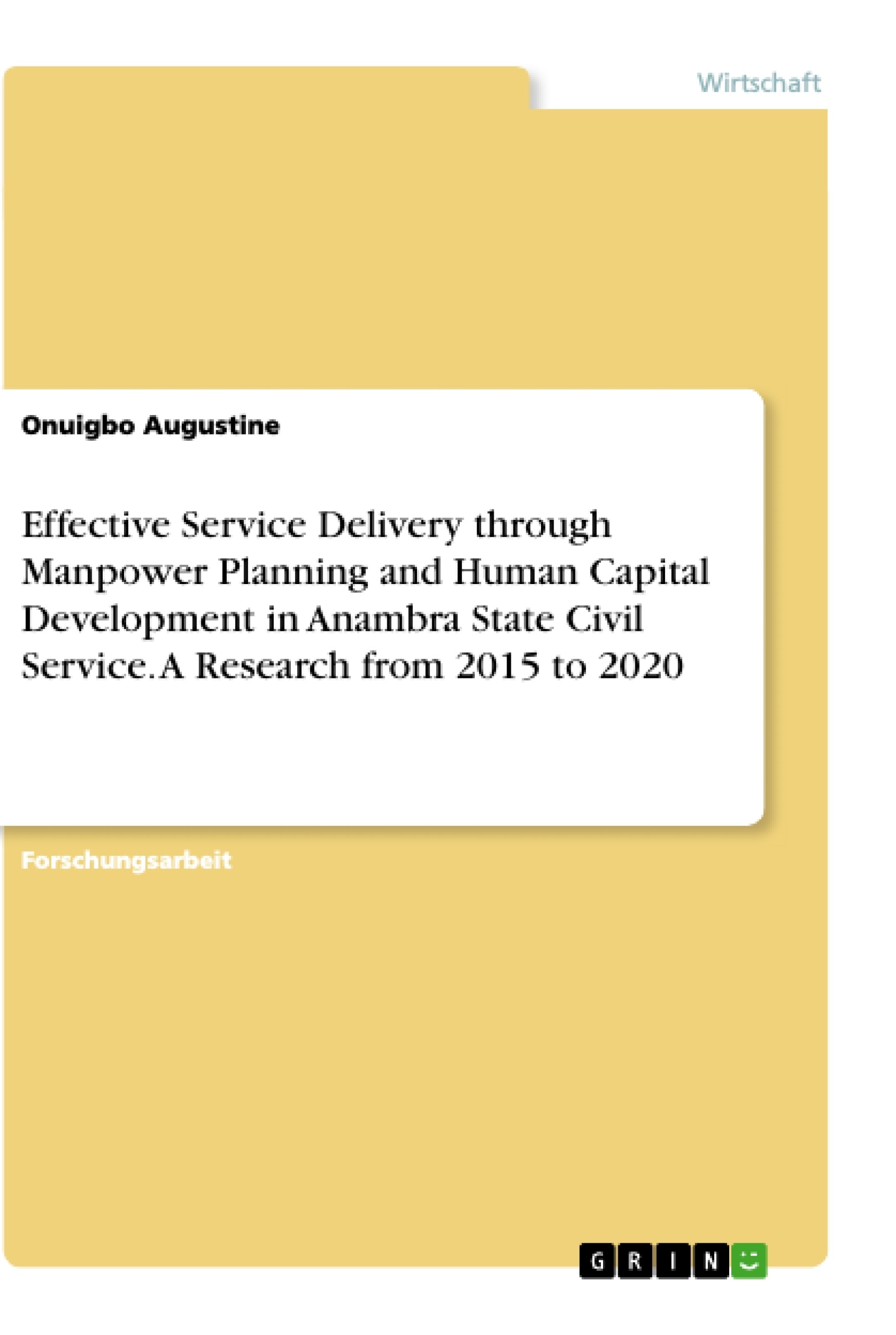The broad objective of the study is to determine the ways of achieving effective service delivery through manpower planning and human capital development in Anambra State Civil Service. It determines the extent to which employees' training and development affects service delivery in Anambra State Civil Service commission. It also examines the extent to which inadequate selections and recruitments and the employees' motivation affects employees’ service delivery in the civil service commission.
The researcher limits this work to the ways of achieving effective service delivery through manpower planning and human capital development in Anambra state civil service covering the period from 2015 to 2020.
Inhaltsverzeichnis
- CHAPTER ONE
- INTRODUCTION
- CHAPTER TWO
- REVIEW OF RELATED LITERAURE
- CHAPTER THREE
- METHODOLOGY
- CHAPTER FOUR
- DATA PRESENTATION AND ANALYSIS.
- CHAPTER FIVE
- SUMMARY OF FINDINGS, CONCLUSION AND RECOMMENDATION
Zielsetzung und Themenschwerpunkte
Diese Arbeit untersucht die Bedeutung von Personalplanung und Humankapitalentwicklung für die effektive Leistungsbereitstellung im öffentlichen Sektor, speziell im Anambra State Civil Service. Die Studie analysiert die Herausforderungen, die mit der unzureichenden Personalplanung in der Vergangenheit verbunden waren, und untersucht den Einfluss dieser Mängel auf die Leistungsfähigkeit des Sektors.
- Die Bedeutung von Personalplanung für die effektive Leistungsbereitstellung im öffentlichen Sektor
- Die Rolle der Humankapitalentwicklung für die Steigerung der Mitarbeitermotivation und -leistung
- Die Herausforderungen der Personalplanung und -entwicklung im Anambra State Civil Service
- Die Auswirkungen unzureichender Personalplanung auf die Leistungsfähigkeit des öffentlichen Sektors
- Strategien zur Verbesserung der Personalplanung und Humankapitalentwicklung im Anambra State Civil Service
Zusammenfassung der Kapitel
- Kapitel 1: Einführung: Das Kapitel legt die Grundlage für die Untersuchung, indem es die Bedeutung von Personalplanung und Humankapitalentwicklung für die effektive Leistungsbereitstellung im öffentlichen Sektor hervorhebt. Es beleuchtet die Herausforderungen, die mit unzureichender Personalplanung in der Vergangenheit verbunden waren, und untersucht den Einfluss dieser Mängel auf die Leistungsfähigkeit des Sektors.
- Kapitel 2: Relevanz der Literatur: Dieses Kapitel analysiert relevante Literatur und Forschungsergebnisse zu den Themen Personalplanung, Humankapitalentwicklung und Leistungsbereitstellung im öffentlichen Sektor. Es beleuchtet verschiedene Theorien und Modelle, die für das Verständnis des Zusammenhangs zwischen Personalplanung und effektiver Leistungsbereitstellung relevant sind.
- Kapitel 3: Methodik: Dieses Kapitel beschreibt die Forschungsmethodik, die für die Untersuchung eingesetzt wird. Es stellt die Forschungsfragen und Hypothesen vor, erläutert das Datenerhebungsverfahren und die Analysemethoden, die zur Beantwortung der Forschungsfragen verwendet werden.
- Kapitel 4: Datenpräsentation und Analyse: Dieses Kapitel präsentiert und analysiert die erhobenen Daten. Es untersucht die Beziehung zwischen Personalplanung und Humankapitalentwicklung auf der einen Seite und der effektiven Leistungsbereitstellung im Anambra State Civil Service auf der anderen Seite.
Schlüsselwörter
Die Schlüsselwörter dieser Arbeit umfassen Personalplanung, Humankapitalentwicklung, effektive Leistungsbereitstellung, öffentlicher Sektor, Anambra State Civil Service, Motivation, Mitarbeiterleistung, Herausforderungen, Strategien.
- Citation du texte
- Onuigbo Augustine (Auteur), 2021, Effective Service Delivery through Manpower Planning and Human Capital Development in Anambra State Civil Service. A Research from 2015 to 2020, Munich, GRIN Verlag, https://www.grin.com/document/1183047



